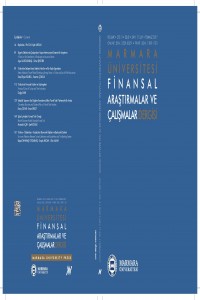Research Article
Year 2017,
Volume: 9 Issue: 17, 149 - 159, 01.07.2017
Abstract
Bu makalede Bankacılık sektöründe müşteri ilişkilerinin önemi ve Kuveyt Türk Katılım Bankasının pilot
aşamasında bulunan, operasyon personelinin pazarlamayı da yapabileceği “Şube İş modeli” anlatılmaya
çalışmıştır. Katılım Bankalarının tercih edilme nedenleri arasında “şube ile müşteri arasındaki ilişki” ilk sırada
bulunmaktadır. Finans sektöründe müşteriyi elde etme ve onu elde tutma ihtiyacı rekabetin arttığı finansal
sektörde önem arz etmektedir. Müşteri ilişkileri; müşterilerin kurumla olan ilişkisini sürdürmek,
kârlılığı sağlamak ve devam ettirmek arzusunda olan kurumların da bir numaralı hedefi haline gelmiştir.
References
- Beitelspacher, L. S., Richey, R.G. & Reynolds, K.E. (2011). Exploring A New Perspective On Coşkun Can AKTAN. Değişim Çağında Yönetim. 2.bs. İstanbul: Sistem Yay. 2005. s.21..
- Defazio, V.J., (2003), Customer Service Leadership Skill and Customer Relationship Management, University of Phoenix, May.
- Edelstein HERB, (2004), “Building Profitable Customer Relationship with Data Mining”,http://www.twocrows. com/crm-dm.pdf/Erişim: 30.09.2004. 1, ss. 154 177.
- Eichorn FRANK L., (2004), “Internal Customer Relationship Management (IntCRM) A Framework for Achieving Customer Relationship Management from the Inside Out”, Problems and Perspectives in Management 1, ss. 154 177.
- Fox TRİCİA ve Steve STEAD, (2001), “Customer Relationship Management Delivering the Benefits”, A White Paper, CRM Ltd and Secor Consulting Ltd. s. 14.
- Görmez B, Özsoy İ. , MEKİK S, Türkiye’de Katılım Bankalarının Tercih Edilme Sebepleri: Ampirik Bir Tetkik, Celal Bayar Üniversitesi, 2013 ERNST & YOUNG, World Islamic Banking Competitiveness Report, 2014 İktisadi ve İdari Bilimler Dergisi, Cilt: 21 Haziran 2007 Sayı: 2 127
- Lee, KUN-HO ve Ullah, SHAKİR (2007), “Integration of Islamic and Conventional Finance”, International Review of Business Research Papers, 3(5), 241-265.
- Mehmet Emin OKUR. “Kurumsal Saygınlık ve Yönetimi”. Marmara Üniversitesi Sosyal Bilimler Enstitüsü Öneri Dergisi. İstanbul. C.: 7. S.: 26. Haziran 2006. s.144.
- Michael HAMMER ve James CHAMPY. Değişim Mühendisliği İş İdaresinde Devrim İçin Bir Manifesto.
- Nancarrow CLİUE, Rees S. ve Stone M., (2003), “New Directions in Customer Research and the Issue of Ownership: A Marketing Research Viewpoint”, Database Marketing- Customer Strategy Management, Vol. 11, ss. 26 39
- Oliver RİCHARD, (1999), “Whence Consumer Loyalty”, Journal of Marketing, Vol. 63, pp. 33 44.
- Ooncharoen, N. & Ussahawanitchakit, P. (2008). Building Organizational Excellence And Business Performance Of Hotel Business In Thailand : effects of service culture and organizational characteristic. International Journal of Business Research, 8(3), 13-26.
- ÖNAL, Recep (2000), Türkiye’de Özel Finans Kurumlarının Dünü, Bugünü ve Yarını Sempozyumu Konuşması [Past, Present and Tomorrow of Special Financial Institutions in Turkey], İstanbul: Albarakatürk Yayınları. Service Efficiency: service culture in retail organizations. Journal of Services Marketing, 25(3), 215–228.
- Sinem GÜL 4.bs. İstanbul: Sabah Kitapları. 1997. s.29.
- Skalen, P. & Strandvik, T. (2005). From Prescription to Description:a critique and reorientation of service culture. Managing Service Quality, 5(3), 230-244
- Ülgen ve Mirze. s.389
- TÜRKMENOĞLU Rüveyda Ebru, “Katılım Bankacılığı ve Türkiye’deki Finansal Yapı”, 2007,s.23
- TÜRKMEN, İ., (2000), Yönetici İçin Etken İletişim Modeli, MPM Yayınları, No:480, Ankara.
- Yang, J.T. (2007). Knowledge Sharing: investigating appropriate leadership roles and collaborative culture. Tourism Management, 28(2), 530-543.
There are 19 citations in total.
Details
| Journal Section | Makaleler |
|---|---|
| Authors | |
| Publication Date | July 1, 2017 |
| Submission Date | October 24, 2017 |
| Published in Issue | Year 2017 Volume: 9 Issue: 17 |

